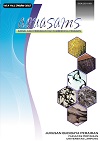ENRICHED LIVE FEED SHOWED DIFFERENT GROWTH AND SURVIVAL TO BLACK TIGER SHRIMP (Penaeus monodon) POST LARVAE 2-13
Abstract
Live feed is used in aquaculture as nutrient and energy source to increase the growth of shrimp. The study of different live feed addition aimed to determine the effectiveness of enrich live feed based on growth and survival rate for black tiger shrimp (Penaeus monodon) post larvae 2-13. The post larvae have initial average weight of 1,17 mg and initial average body length of 5,3 mm. This study design using completely randomized design with four treatments and four replications were used : Artemia naupli enriched with fish oil, Branchionus plicatilis enriched with Tetraselmis chuii, Branchionus plicatilis enriched with Nannochloropsis, Branchionus plicatilis enriched with Tetraselmis chuii and Nannochloropsis. Shrimp was kept during 14 days for studying enrich live feed which were effective for the shrimp. The data was analyzed with ANOVA and continued with the LSD test. The research showed that different live feed addition give different growth. Artemia naupli enriched with fish oil is optimum for black tiger shrimp growth with body weight of 2,61 mg, body length of 5,96 mm, and survival rate of 89% (P<005) . It showed that enriched live feed will change contens of nutrien in live feed ang give positive response on growth and survival rate. This research support application of effective live feed management for adapting black tiger shrimp’s metamorphose in short time.

.png)










